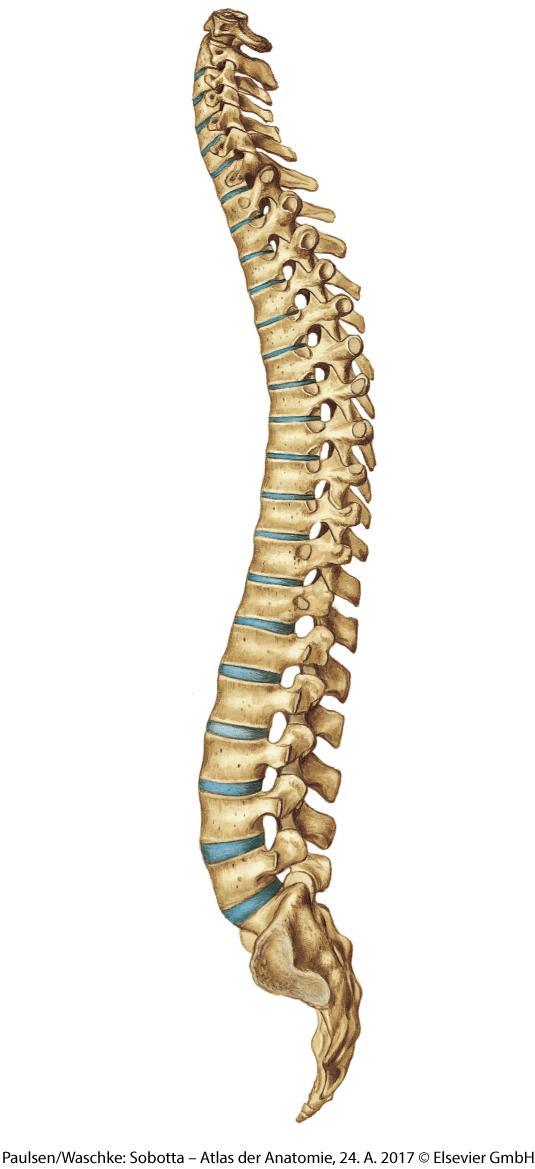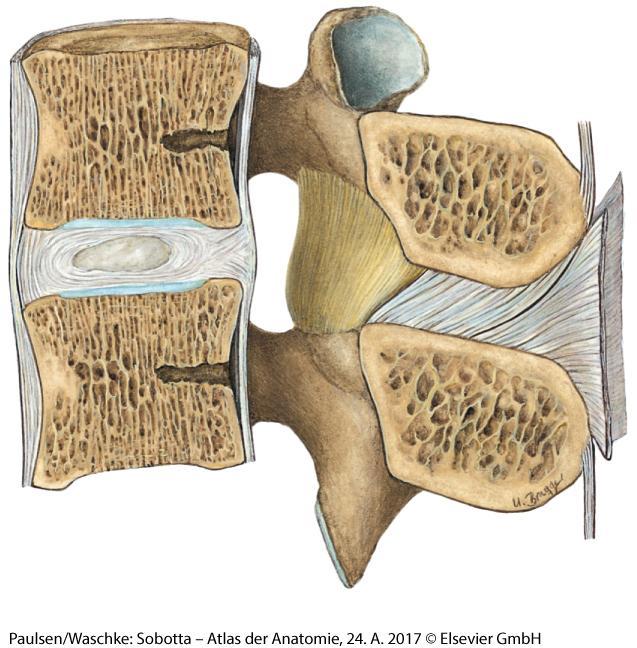
Picture: Healthy human spine has this kind of S-curve. The 24 vertebrae and disks, 48 facet joints in vertebrae, and huge amounts of ligaments make it a very detailed organ which has lots of dysfunctions in our modern life where people spend long hours sitting in poor postures. In the long run only good posture can keep the spine healthy and that can be attained with a two-part saddle chair.
Original source of picture: Paulsen, Waschke, Sobotta Atlas of Human Anatomy, 15th Edition 2011©Elsevier GmbH, Urban & Fischer, Munich.
What is a good sitting position like?
Traditional sitting on a chair with 90° degree angles in hips and knees inevitably makes people slouch. When sitting on a saddle chair the thighs are in a 90° degree angle in relation to each other and pointing downwards in an approximately 45° degree angle. The pelvis is tilting forward, not backward, like in traditional sitting. In other words, on a saddle chair the pelvis is in a “standing” posture and thus we achieve the healthy posture on the back almost automatically. The lumbar vertebrae are in their natural position and the lower back forms a correct curve, lordosis. This posture can only be maintained on a two-part saddle chair that does not press the genital area and thus allows tilting the pelvis forward comfortably.
This position of the lumbar vertebrae prevents deteriorative damage to the lower back and in most cases quickly decreases pain in the typical lower back/disk problems. In addition, the circulation in the lower back is improved, since the improved posture relieves muscle tension and especially improves the activeness in numerous back muscles. The increased circulation, in turn, increases the oxygen and nutrient contents in the muscles, the absence of which is probably the main cause for the common degeneration syndrome of the lower back.
How to prevent lower back pain
Since the disks and ligaments have no blood circulation of their own (circulation is also very weak in the vertebrae), it is essential for the lower back to have good circulation so that the tissues can get sufficient amount of nutrients and oxygen and remove wastes. In a physically active back, or in a good posture, this metabolism works well. The arteries of the lower back are surprisingly small and require good muscle activity and relaxation to bring enough blood to prevent degeneration of tissues.
Upright sitting on an ergonomic saddle chair
Sitting in a good posture on a saddle chair makes it possible to use the whole body in an effortless and natural way, giving the muscles of the lower back exercise-like movement. The upper body moves, when the chair is rolled from one place to another or reaching movements are made. We call this activity “Roll and Reach”, and it is very helpful in reducing dangerous inactivity during sitting.
Moving with the chair or reaching for things is easy and risk-free, as the feet rest firmly on the floor and the back is able to maintain the good posture with the help of the support from the legs. Correct use of back muscles leads to a gradual improvement in posture and prevents ailments caused by scoliosis.
Prevent sciatic problems and prolapsed disk
When sitting upright on a saddle chair, also the sciatic nerve pains become less frequent as the deterioration of the lower back slows down. Typically the sciatic nerve is irritated (and causes pain) when the nerve canal becomes too contracted as a result of the flattening of the disk. The nerve canal can become congested also after changes in the bone structure resulting from lower back deterioration.

Swing mechanism in the two-part saddle chair makes it considerably easier to reach for things, and it also increases circulation (also lymphatic circulation) and muscle activity mainly in the lower back and pelvic area. The users tend to create movement also unnoticed when the body “asks for” activation. Such unconscious movements are swinging the pelvis, smaller or bigger exercise movements and rolling and reaching too.
Picture: This close-up reveals how well protected the liquid “bubble”, Nucleus pulposus, is in the centre of the disk. Yet long-term bad sitting or some trauma can make it come out and cause a prolapse that presses some nerve causing a lot of pain. The permanent stretching of the ligament interspinale causes worsening posture, even when you are standing. Good posture does not increase the risk of prolapse but rehabilitates fast the already existing prolapses.
Original source of picture: Paulsen, Waschke, Sobotta Atlas of Human Anatomy, 15th Edition 2011©Elsevier GmbH, Urban & Fischer, Munich.
